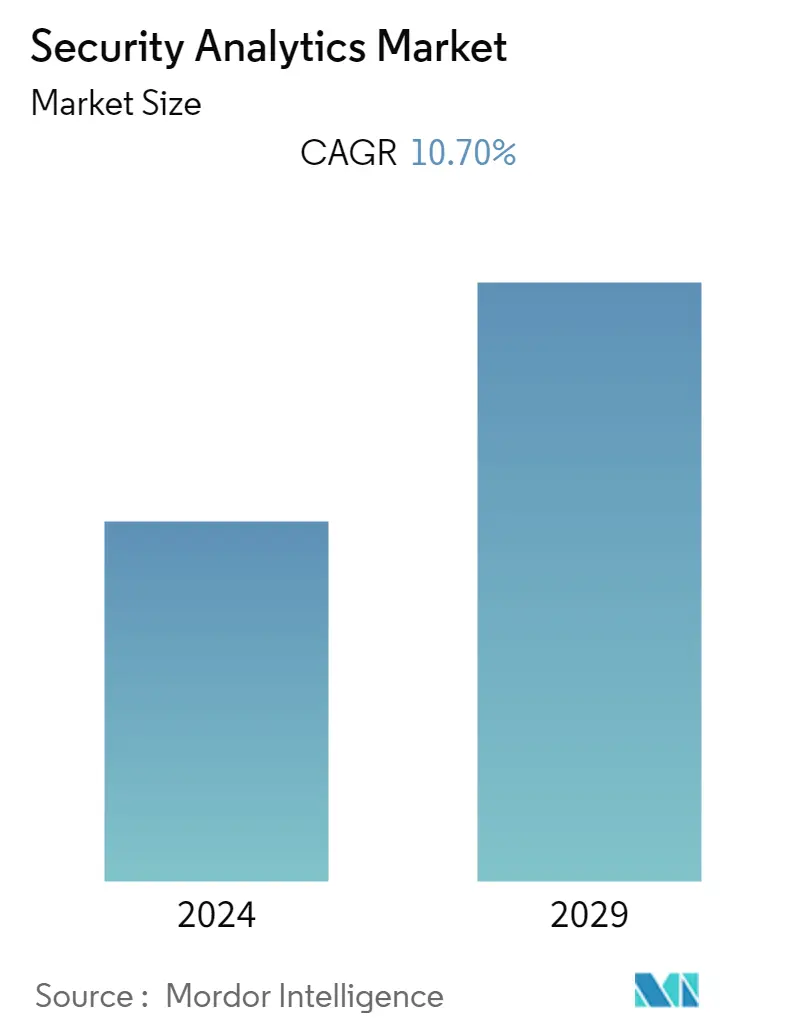Market Size of Security Analytics Industry

| Study Period | 2019 - 2029 |
| Base Year For Estimation | 2023 |
| CAGR | 10.70 % |
| Fastest Growing Market | Asia-Pacific |
| Largest Market | North America |
| Market Concentration | Low |
Major Players
*Disclaimer: Major Players sorted in no particular order |
Security Analytics Market Analysis
The security analytics market will register a CAGR of 10.7% during the forecast period. Cyberattack types and frequency have exponentially increased due to the internet's rapid expansion. The growth of big data across computer networks quickly makes these conventional methods obsolete, even though several well-known cybersecurity solutions are used to defend against these threats.
- Security analytics work with IT resources and use automated security intelligence to respond to the constant changes in the environment.Automating and making tactical modifications should be firmly connected with security policy controls.
- The current network architecture is more vulnerable to hackers because of the growth of IoT and the speed and scope of digital transformation. Big data analytics will be a key part of any effective cyber security solution because it will be necessary to quickly process the high-velocity, high-volume data from many different sources in order to find anomalies and attack patterns as soon as possible. This will make the systems less vulnerable and more resilient.
- Rules-based detection has given way to data science techniques like machine learning (ML) and artificial intelligence (AI) in security analytics solutions. This is a response to outside problems like more data, more complicated infrastructure, and a lack of skilled security experts. Most of the time, for security teams to be effective, they need to combine security analytics with a huge amount of machine-generated data.
- Costs are much higher for businesses of all sizes because there are more and more data breaches and more documents that are affected.
- The COVID-19 epidemic significantly impacted the world economy and changed people's communication and work. These drastic changes helped spammers and hackers thrive in the cyber world. Because of this, it was predicted that the security analytics market would benefit significantly from the rise in cyberattacks caused by the pandemic.
Security Analytics Industry Segmentation
Security analytics uses tools to collect, combine, and analyze data to keep an eye on security and find threats.Security analytics data can be collected in several ways, including network traffic. Endpoint and user behavior data. With the increasing use of the internet in both developed and developing countries, security analytic solutions should become more widely adopted because the internet is now connected to every technology in the modern world, giving cybercriminals easier access to data.
The security analytics market is segmented by application (network security analytics, application security analytics, web security analytics, and endpoint security analytics), end-user industry (healthcare, defense and security, banking and financial services, telecom and IT), and geography (North America, Europe, Asia Pacific, Latin America, the Middle East, and Africa). The market sizes and forecasts are provided in terms of value (USD billion) for all the above segments.
| By Application | |
| Network Security Analytics | |
| Application Security Analytics | |
| Web Security Analytics | |
| Endpoint Security Analytics |
| By End-user Industry | |
| Healthcare | |
| Defense and Security | |
| Banking and Financial Services | |
| Telecom and IT |
| By Geography | |
| North America | |
| Europe | |
| Asia-Pacific | |
| Latin America | |
| Middle East & Africa |
Security Analytics Market Size Summary
The security analytics market is experiencing significant growth, driven by the increasing frequency and sophistication of cyberattacks, which have been exacerbated by the rapid expansion of the internet and the proliferation of IoT devices. Traditional cybersecurity methods are becoming obsolete due to the vast amounts of data generated across networks, necessitating the adoption of big data analytics as a core component of effective cybersecurity solutions. This shift is further supported by advancements in machine learning and artificial intelligence, which are replacing conventional rules-based detection methods to address the complexities of modern cyber threats. The market is characterized by a growing need for automated security intelligence to enhance resilience against attacks and reduce vulnerabilities in network architectures.
North America stands out as a key region for the security analytics market, with the United States and Canada leading in adoption due to supportive government policies, a robust industrial base, and high purchasing power. The region's market growth is fueled by the increasing number of data breaches and malware attacks, alongside a rising demand for security compliance management systems. Major players in the market, such as Cylance Inc. and Securonix, are driving innovation through strategic partnerships and cloud-based solutions. The network security market is highly competitive, with global and regional players like IBM, McAfee, and Cisco offering a range of products to meet the growing demand for comprehensive cybersecurity solutions.
Security Analytics Market Size - Table of Contents
-
1. MARKET INSIGHTS
-
1.1 Market Overview
-
1.2 Industry Value Chain Analysis
-
1.3 Industry Attractiveness Porter's Five Forces Analysis
-
1.3.1 Threat of New Entrants
-
1.3.2 Bargaining Power of Buyers/Consumers
-
1.3.3 Bargaining Power of Suppliers
-
1.3.4 Threat of Substitute Products
-
1.3.5 Intensity of Competitive Rivalry
-
-
1.4 Assessment of COVID-19 Impact on the market
-
-
2. MARKET SEGMENTATION
-
2.1 By Application
-
2.1.1 Network Security Analytics
-
2.1.2 Application Security Analytics
-
2.1.3 Web Security Analytics
-
2.1.4 Endpoint Security Analytics
-
-
2.2 By End-user Industry
-
2.2.1 Healthcare
-
2.2.2 Defense and Security
-
2.2.3 Banking and Financial Services
-
2.2.4 Telecom and IT
-
-
2.3 By Geography
-
2.3.1 North America
-
2.3.2 Europe
-
2.3.3 Asia-Pacific
-
2.3.4 Latin America
-
2.3.5 Middle East & Africa
-
-
Security Analytics Market Size FAQs
What is the current Security Analytics Market size?
The Security Analytics Market is projected to register a CAGR of 10.70% during the forecast period (2024-2029)
Who are the key players in Security Analytics Market?
Alert Logic Inc., Arbor Networks Inc., Broadcom Inc. (Symantec Corporation), Cisco Systems Inc. and RSA Security LLC are the major companies operating in the Security Analytics Market.

